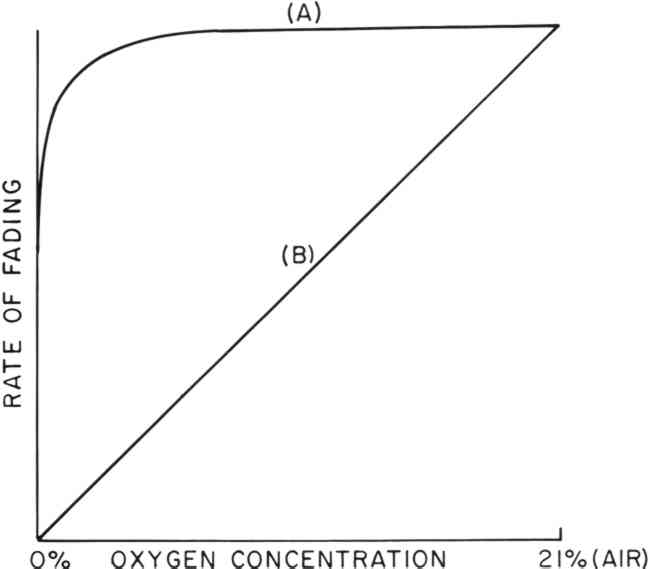THE INFLUENCE OF OXYGEN ON THE FADING OF ORGANIC COLORANTSJ. S. Arney, A. J. Jacobs, & R. Newman
2 BACKGROUNDIT HAS LONG been known that the light-induced fading of many organic colorants can be inhibited by replacing the air surrounding the colorant with an oxygen-free gas.1,6 However, a complete halt of the fading process under such conditions is generally not observed. In accounting for this non-zero rate of fading, it might seem reasonable to assume that chemical reactions are taking place that do not require oxygen. However, it is not possible to eliminate completely all of the oxygen from a Thomson has suggested that the oxidative degradation of most organic materials would show little or no decrease in rate of degradation until parts-per-million levels of oxygen were achieved.7Figure 1, curve A, illustrates the relationship between fading rate and oxygen concentration that might be observed if Thomson's prediction were to apply.
However, Giles has suggested that the rate of fading of most organic colorants should decrease linearly with a decrease in oxygen concentration8, as shown in Figure 1, curve B. If curve B were to apply, then fading could be decreased by 90% with as much as 2% residual oxygen surrounding the colorant. On the other hand, if curve A were to apply, then extremely rigorous measures would be required to achieve a significant enhancement in the permanence of a colorant. Although display cases capable of maintaining such an environment have been constructed4, the cost of construction and maintenance are prohibitive. We have found only one report, published by Lasareff in 19129, quantitatively relating rates of fading to oxygen concentration. Lasareff reported that the fading rates of two cyanine dyes decreased linearly (curve B) with a decrease in oxygen concentration. Our research was undertaken to obtain additional data on rate versus oxygen-concentration relationships. |
